steering SUBARU LEGACY 2005 4.G Owner's Guide
[x] Cancel search | Manufacturer: SUBARU, Model Year: 2005, Model line: LEGACY, Model: SUBARU LEGACY 2005 4.GPages: 627, PDF Size: 6.42 MB
Page 453 of 627
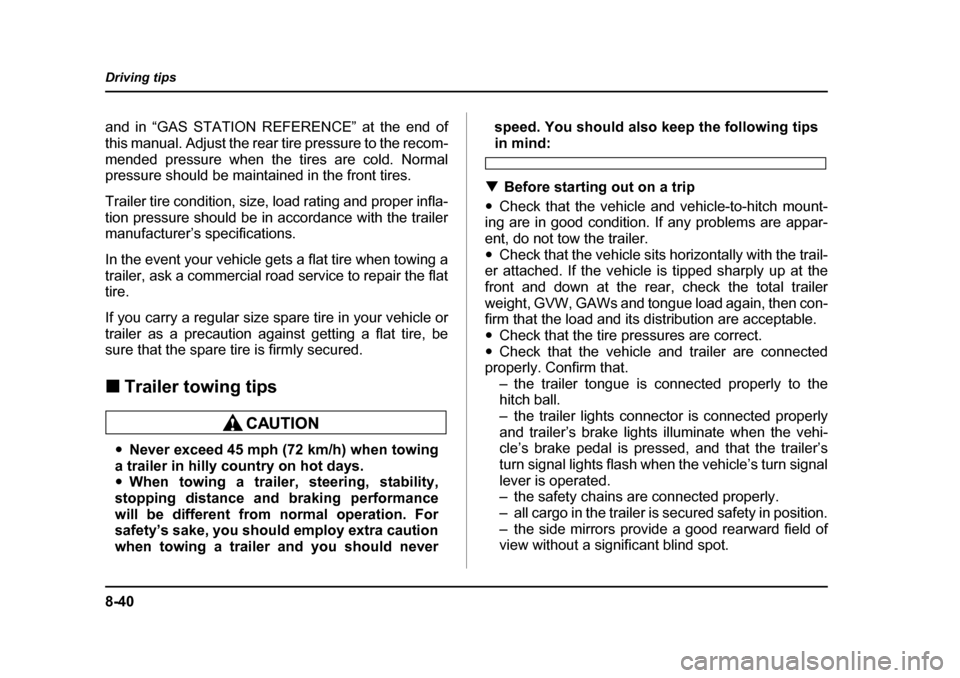
8-40
Driving tips
and in “GAS STATION REFERENCE” at the end of
this manual. Adjust the rear tire pressure to the recom-
mended pressure when the tires are cold. Normal
pressure should be maintained in the front tires.
Trailer tire condition, size, load rating and proper infla-
tion pressure should be in accordance with the trailer
manufacturer’s specifications.
In the event your vehicle gets a flat tire when towing a
trailer, ask a commercial road service to repair the flat tire.
If you carry a regular size spare tire in your vehicle or
trailer as a precaution against getting a flat tire, be
sure that the spare tire is firmly secured. !
Trailer towing tips
"Never exceed 45 mph (72 km/h) when towing
a trailer in hilly country on hot days. " When towing a trailer, steering, stability,
stopping distance and braking performance
will be different from normal operation. For
safety’s sake, you should employ extra caution
when towing a trailer and you should never speed. You should also keep the following tips
in mind:
! Before starting out on a trip
" Check that the vehicle and vehicle-to-hitch mount-
ing are in good condition. If any problems are appar-
ent, do not tow the trailer." Check that the vehicle sits horizontally with the trail-
er attached. If the vehicle is tipped sharply up at the
front and down at the rear, check the total trailer
weight, GVW, GAWs and tongue load again, then con-
firm that the load and its distribution are acceptable. " Check that the tire pressures are correct.
" Check that the vehicle and trailer are connected
properly. Confirm that.
– the trailer tongue is connected properly to the
hitch ball.
– the trailer lights connector is connected properly
and trailer’s brake lights illuminate when the vehi-
cle’s brake pedal is pressed, and that the trailer’s
turn signal lights flash when the vehicle’s turn signal
lever is operated.
– the safety chains are connected properly.
– all cargo in the trailer is secured safety in position.
– the side mirrors provide a good rearward field of
view without a significant blind spot.
Page 454 of 627
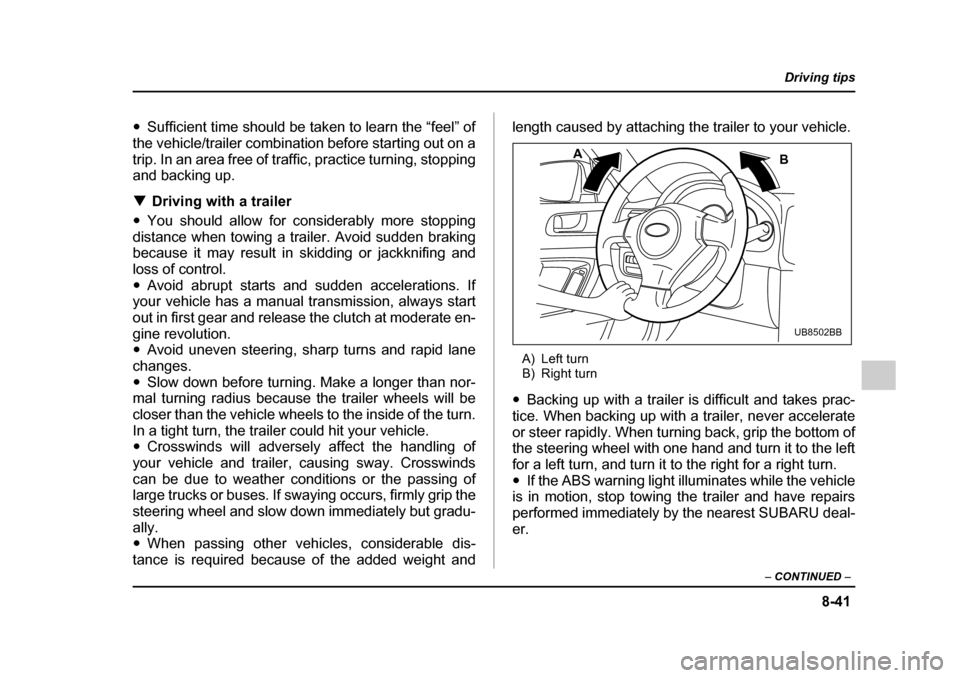
8-41
Driving tips
– CONTINUED –
"Sufficient time should be taken to learn the “feel” of
the vehicle/trailer combination before starting out on a
trip. In an area free of traffic, practice turning, stopping
and backing up. ! Driving with a trailer
" You should allow for considerably more stopping
distance when towing a trailer. Avoid sudden braking because it may result in skidding or jackknifing and
loss of control." Avoid abrupt starts and sudden accelerations. If
your vehicle has a manual transmission, always start
out in first gear and release the clutch at moderate en-
gine revolution. " Avoid uneven steering, sharp turns and rapid lane
changes. " Slow down before turning. Make a longer than nor-
mal turning radius because the trailer wheels will be
closer than the vehicle wheels to the inside of the turn.
In a tight turn, the trailer could hit your vehicle. " Crosswinds will adversely affect the handling of
your vehicle and trailer, causing sway. Crosswinds
can be due to weather conditions or the passing of large trucks or buses. If swaying occurs, firmly grip the
steering wheel and slow down immediately but gradu-
ally. " When passing other vehicles, considerable dis-
tance is required because of the added weight and length caused by attaching the trailer to your vehicle.
A) Left turn
B) Right turn
" Backing up with a trailer is difficult and takes prac-
tice. When backing up with a trailer, never accelerate
or steer rapidly. When turning back, grip the bottom of
the steering wheel with one hand and turn it to the left
for a left turn, and turn it to the right for a right turn. " If the ABS warning light illuminates while the vehicle
is in motion, stop towing the trailer and have repairs
performed immediately by the nearest SUBARU deal- er.
A B
UB8502BB
Page 483 of 627
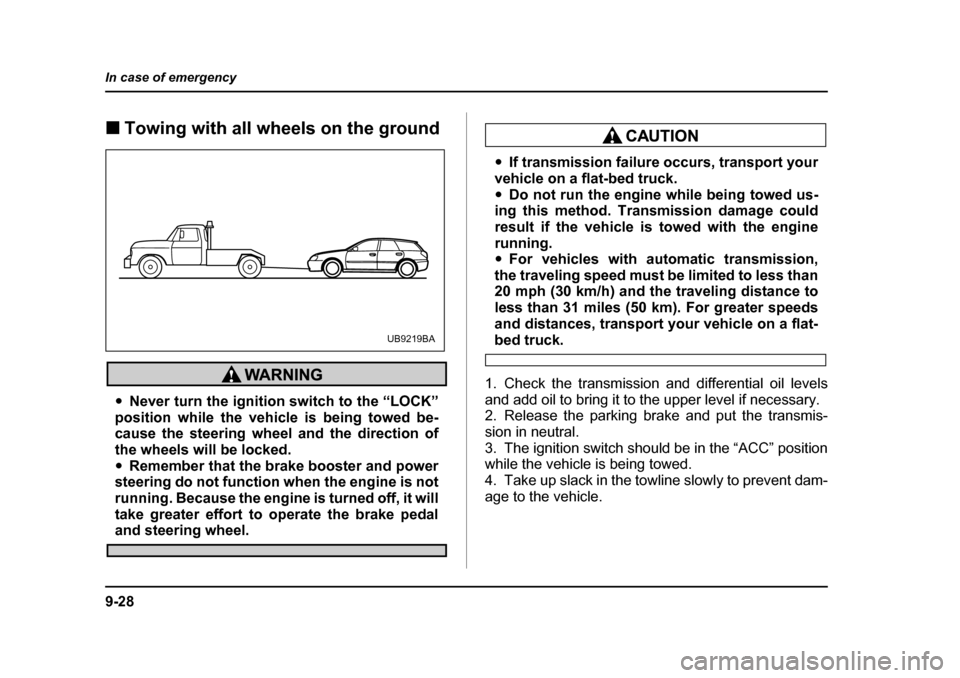
9-28
In case of emergency
!
Towing with all wheels on the ground
"Never turn the ignition switch to the “LOCK”
position while the vehicle is being towed be-
cause the steering wheel and the direction of
the wheels will be locked." Remember that the brake booster and power
steering do not function when the engine is not
running. Because the engine is turned off, it will
take greater effort to operate the brake pedal
and steering wheel.
" If transmission failure occurs, transport your
vehicle on a flat-bed truck. " Do not run the engine while being towed us-
ing this method. Transmission damage could
result if the vehicle is towed with the engine
running. " For vehicles with automatic transmission,
the traveling speed must be limited to less than
20 mph (30 km/h) and the traveling distance to
less than 31 miles (50 km). For greater speeds
and distances, transport your vehicle on a flat-
bed truck.
1. Check the transmission and differential oil levels
and add oil to bring it to the upper level if necessary.
2. Release the parking brake and put the transmis-
sion in neutral.
3. The ignition switch should be in the “ACC” position
while the vehicle is being towed.
4. Take up slack in the towline slowly to prevent dam-
age to the vehicle.UB9219BA
Page 493 of 627
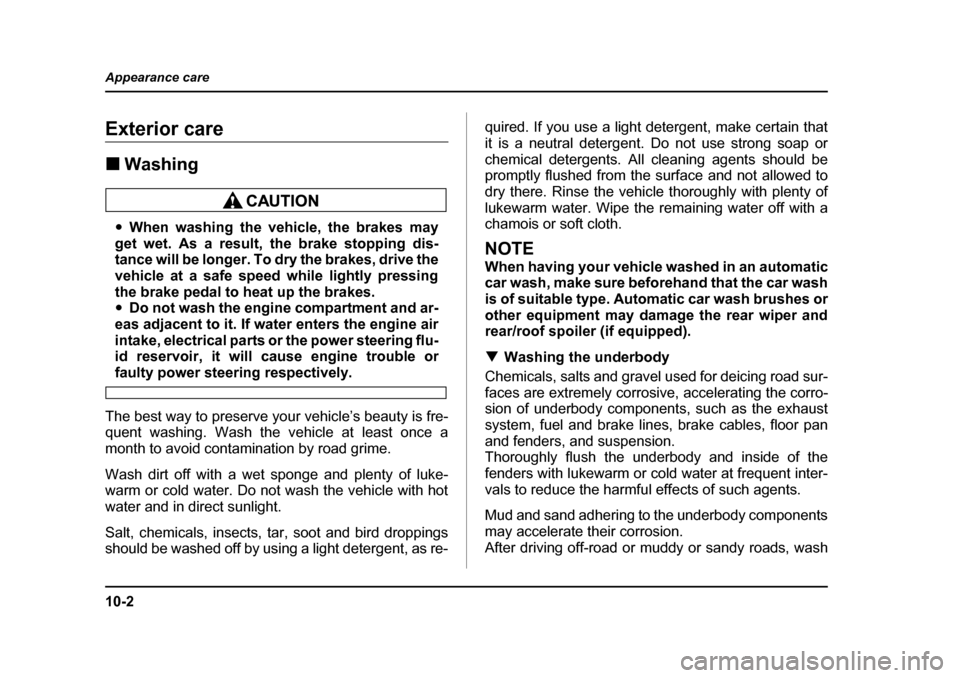
10-2
Appearance care
Appearance careExterior care !
Washing
"When washing the vehicle, the brakes may
get wet. As a result, the brake stopping dis-
tance will be longer. To dry the brakes, drive the
vehicle at a safe speed while lightly pressing
the brake pedal to heat up the brakes." Do not wash the engine compartment and ar-
eas adjacent to it. If water enters the engine air
intake, electrical parts or the power steering flu-
id reservoir, it will cause engine trouble or
faulty power steering respectively.
The best way to preserve your vehicle’s beauty is fre-
quent washing. Wash the vehicle at least once a
month to avoid contamination by road grime.
Wash dirt off with a wet sponge and plenty of luke-
warm or cold water. Do not wash the vehicle with hot
water and in direct sunlight.
Salt, chemicals, insects, tar, soot and bird droppings
should be washed off by using a light detergent, as re- quired. If you use a light detergent, make certain that
it is a neutral detergent. Do not use strong soap or
chemical detergents. All cleaning agents should be
promptly flushed from the surface and not allowed to
dry there. Rinse the vehicle thoroughly with plenty of
lukewarm water. Wipe the remaining water off with a
chamois or soft cloth.
NOTE
When having your vehicle washed in an automatic
car wash, make sure beforehand that the car wash
is of suitable type. Automatic car wash brushes or
other equipment may damage the rear wiper and
rear/roof spoiler (if equipped). !
Washing the underbody
Chemicals, salts and gravel used for deicing road sur-
faces are extremely corrosive, accelerating the corro-
sion of underbody components, such as the exhaust
system, fuel and brake lines, brake cables, floor pan
and fenders, and suspension.
Thoroughly flush the underbody and inside of the
fenders with lukewarm or cold water at frequent inter-
vals to reduce the harmful effects of such agents.
Mud and sand adhering to the underbody components may accelerate their corrosion.
After driving off-road or muddy or sandy roads, wash
Page 500 of 627

11 - 1
11
Maintenance and service
Maintenance schedule ................................. 11-3
Maintenance precautions ............................ 11-3 Before checking or servicing in the engine compartment .................................................. 11-4
When you do checking or servicing in the engine compartment while the engine is
running ............................................................ 11-5
Engine hood .................................................. 11-5
Engine compartment overview ................... 11-8 2.5-liter non-turbo models ................................ 11-8
2.5-liter non-turbo California-spec. models .... 11-9
2.5-liter turbo models ....................................... 11-10
3.0-liter models .................................................. 11-11
Engine oil ...................................................... 11-12 Checking the oil level ....................................... 11-12
Changing the oil and oil filter .......................... 11-13
Recommended grade and viscosity ................ 11-16
Recommended grade and viscosity under severe driving conditions .............................. 11-17
Cooling system ............................................. 11-18 Hose and connections ...................................... 11-19
Engine coolant .................................................. 11-19
Air cleaner element ...................................... 11-24 Replacing the air cleaner element ................... 11-24
Spark plugs ................................................... 11-29 Recommended spark plugs ............................. 11-29
Drive belts ..................................................... 11-30 2.5-liter models .................................................. 11-30
3.0-liter models .................................................. 11-30
Manual transmission oil ............................... 11-31 Checking the oil level ....................................... 11-31
Recommended grade and viscosity ............... 11-32
Automatic transmission fluid ...................... 11-33 Checking the fluid level .................................... 11-33
Recommended fluid ......................................... 11-35
Front differential gear oil (AT vehicles) ...... 11-35 Checking the oil level ....................................... 11-35
Recommended grade and viscosity ............... 11-36
Rear differential gear oil ............................... 11-37 Checking the gear oil level .............................. 11-37
Recommended grade and viscosity ............... 11-40
Power steering fluid ...................................... 11-41 Checking the fluid level .................................... 11-41
Recommended fluid ......................................... 11-42
Brake fluid ..................................................... 11-42 Checking the fluid level .................................... 11-42
Recommended brake fluid ............................... 11-43
Clutch fluid (MT vehicles) ............................ 11-43 Checking the fluid level .................................... 11-43
Recommended clutch fluid .............................. 11-44
Brake booster ................................................ 11-44
Brake pedal .................................................... 11-45 Checking the brake pedal free play ................ 11-45
Checking the brake pedal reserve distance ... 11-45
Clutch pedal (Manual transmission vehicles) ..................................................... 11-46Checking the clutch function .......................... 11-46
Checking the clutch pedal free play ............... 11-46
Replacement of brake pad and lining ......... 11-47
Page 507 of 627
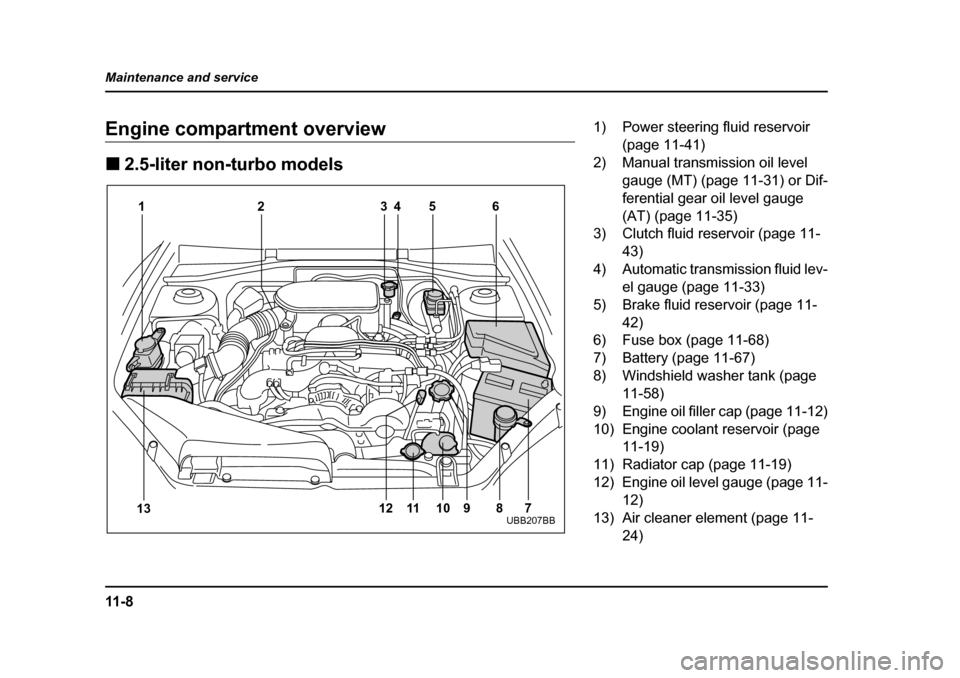
11 - 8
Maintenance and service
Engine compartment overview !
2.5-liter non-turbo models
12 3 45 6
7
8
9
10
11
13 12
UBB207BB
1) Power steering fluid reservoir
(page 11-41)
2) Manual transmission oil level gauge (MT) (page 11-31) or Dif-
ferential gear oil level gauge
(AT) (page 11-35)
3) Clutch fluid reservoir (page 11-
43)
4) Automatic transmission fluid lev- el gauge (page 11-33)
5) Brake fluid reservoir (page 11- 42)
6) Fuse box (page 11-68)
7) Battery (page 11-67)
8) Windshield washer tank (page 11-58)
9) Engine oil filler cap (page 11-12)
10) Engine coolant reservoir (page 11-19)
11) Radiator cap (page 11-19)
12) Engine oil level gauge (page 11- 12)
13) Air cleaner element (page 11- 24)
Page 508 of 627
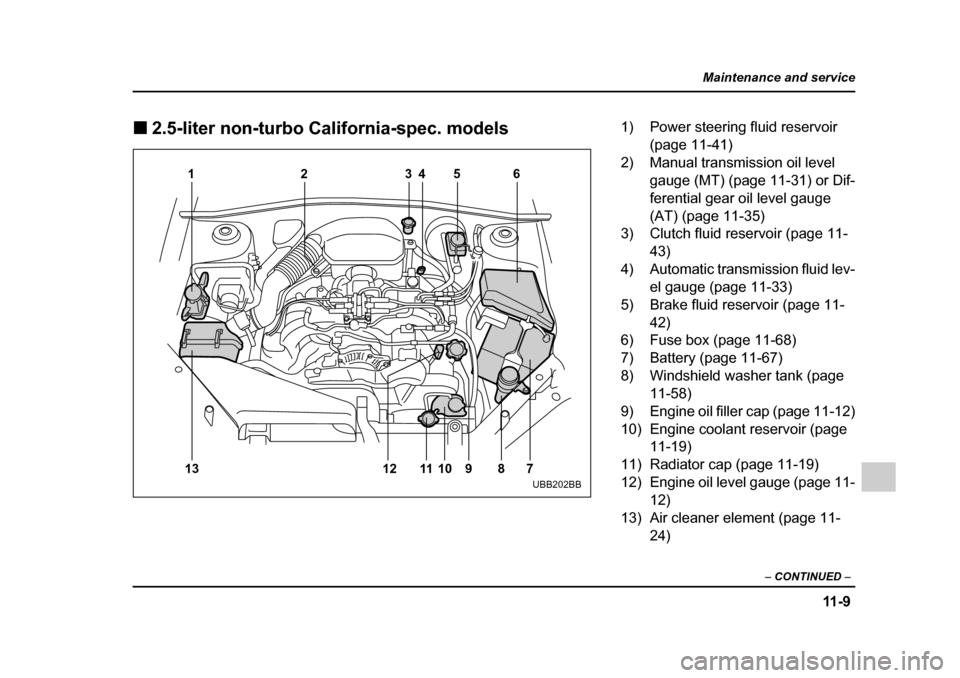
11 - 9
Maintenance and service
– CONTINUED –
!2.5-liter non-turbo California-spec. models
123 45 6
7
8
9
10
11
13 12
UBB202BB
1) Power steering fluid reservoir
(page 11-41)
2) Manual transmission oil level gauge (MT) (page 11-31) or Dif-
ferential gear oil level gauge
(AT) (page 11-35)
3) Clutch fluid reservoir (page 11-
43)
4) Automatic transmission fluid lev- el gauge (page 11-33)
5) Brake fluid reservoir (page 11- 42)
6) Fuse box (page 11-68)
7) Battery (page 11-67)
8) Windshield washer tank (page 11-58)
9) Engine oil filler cap (page 11-12)
10) Engine coolant reservoir (page 11-19)
11) Radiator cap (page 11-19)
12) Engine oil level gauge (page 11- 12)
13) Air cleaner element (page 11- 24)
Page 509 of 627
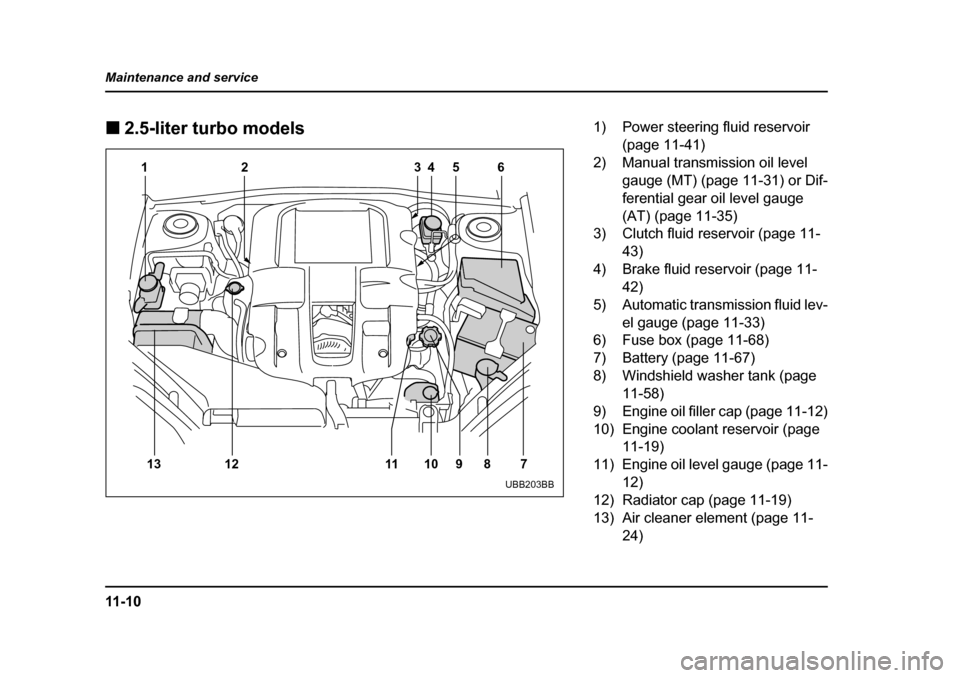
11 - 1 0
Maintenance and service !
2.5-liter turbo models
12 4 6
35
13 12 11 10 9 8 7
UBB203BB
1) Power steering fluid reservoir (page 11-41)
2) Manual transmission oil level gauge (MT) (page 11-31) or Dif-
ferential gear oil level gauge
(AT) (page 11-35)
3) Clutch fluid reservoir (page 11-
43)
4) Brake fluid reservoir (page 11- 42)
5) Automatic transmission fluid lev- el gauge (page 11-33)
6) Fuse box (page 11-68)
7) Battery (page 11-67)
8) Windshield washer tank (page 11-58)
9) Engine oil filler cap (page 11-12)
10) Engine coolant reservoir (page 11-19)
11) Engine oil level gauge (page 11- 12)
12) Radiator cap (page 11-19)
13) Air cleaner element (page 11- 24)
Page 510 of 627
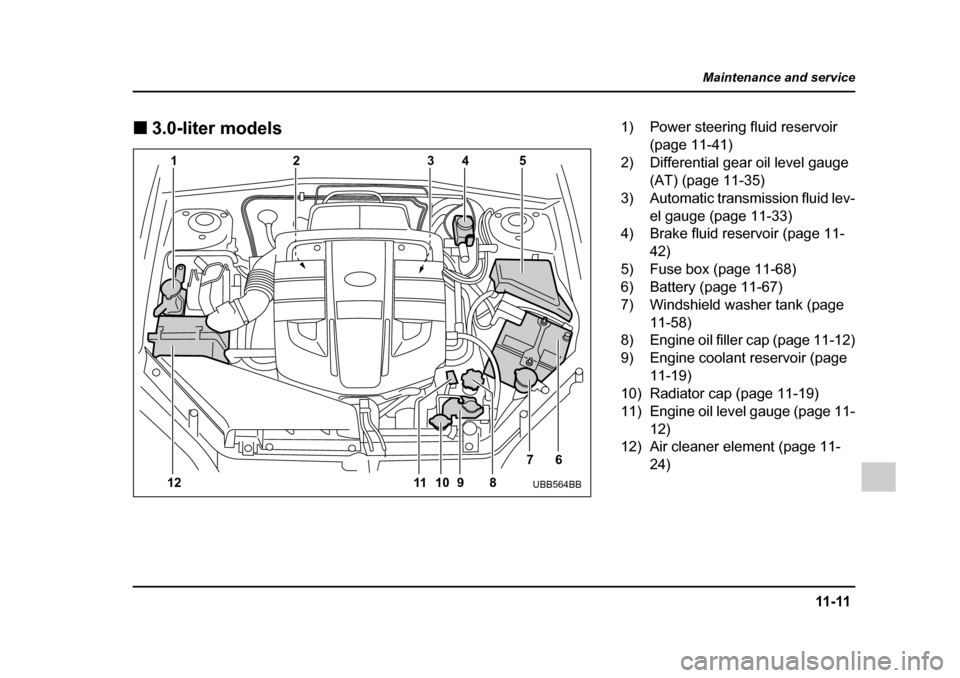
11-11
Maintenance and service
– CONTINUED –
!3.0-liter models
12 3 45
12 10
11 9 8 76
UBB564BB
1) Power steering fluid reservoir
(page 11-41)
2) Differential gear oil level gauge (AT) (page 11-35)
3) Automatic transmission fluid lev- el gauge (page 11-33)
4) Brake fluid reservoir (page 11-
42)
5) Fuse box (page 11-68)
6) Battery (page 11-67)
7) Windshield washer tank (page 11-58)
8) Engine oil filler cap (page 11-12)
9) Engine coolant reservoir (page 11-19)
10) Radiator cap (page 11-19)
11) Engine oil level gauge (page 11- 12)
12) Air cleaner element (page 11-
24)
Page 529 of 627
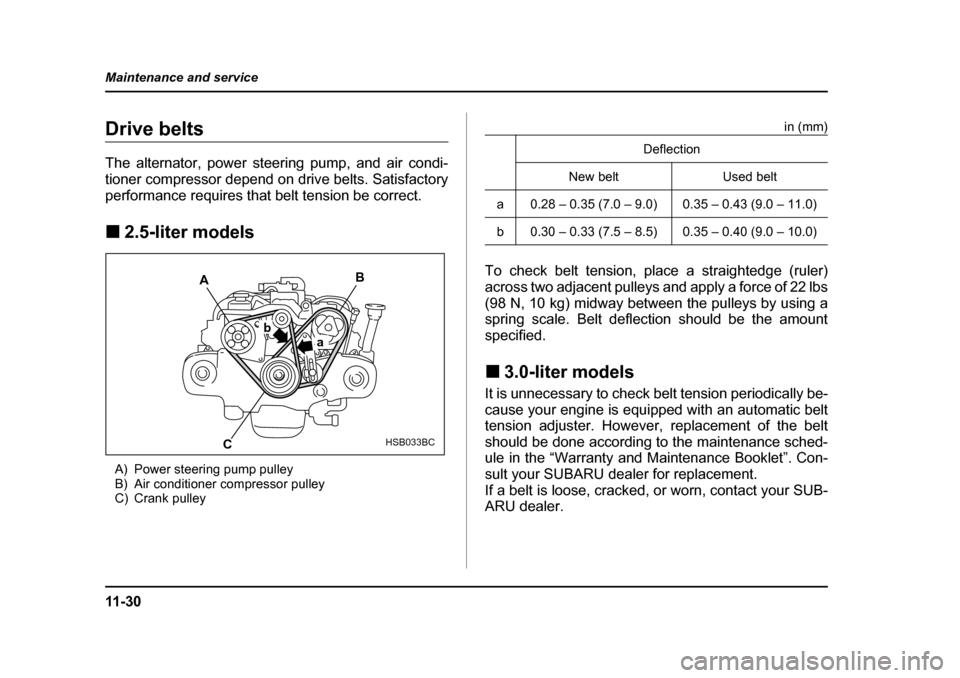
11 - 3 0
Maintenance and service
Drive belts
The alternator, power steering pump, and air condi-
tioner compressor depend on drive belts. Satisfactory
performance requires that belt tension be correct. !
2.5-liter models
A) Power steering pump pulley
B) Air conditioner compressor pulley
C) Crank pulley in (mm)
To check belt tension, place a straightedge (ruler)
across two adjacent pulleys and apply a force of 22 lbs
(98 N, 10 kg) midway between the pulleys by using a
spring scale. Belt deflection should be the amount
specified. ! 3.0-liter models
It is unnecessary to check belt tension periodically be-
cause your engine is equipped with an automatic belt
tension adjuster. However, replacement of the belt
should be done according to the maintenance sched-
ule in the “Warranty and Maintenance Booklet”. Con-
sult your SUBARU dealer for replacement.
If a belt is loose, cracked, or worn, contact your SUB-
ARU dealer.
B
C a
b
A
HSB033BC
Deflection
New belt Used belt
a 0.28 – 0.35 (7.0 – 9.0) 0.35 – 0.43 (9.0 – 11.0)
b 0.30 – 0.33 (7.5 – 8.5) 0.35 – 0.40 (9.0 – 10.0)